
Search
The Renewable Energy site for Do-It-Yourselfers
Collector
Construction Details
This page covers the details on
making the solar collectors.
Making the Copper Tube Grid for the
Absorber
I decided on ½ in copper runners 6
in. apart with ¾ pipe headers. I saw a tool on the internet to draw a half inch
flange out of a ¾ pipe and copied the tool using a Grade-8 fine thread bolt. To
make it, grind the bold into a bell shape with a 5/16 shank then grind it flat
on both sides to 5/16 thick ,then cut the slot.
All the details on making the Pipe Flaring Tool are here...
Click on pictures for full size
|
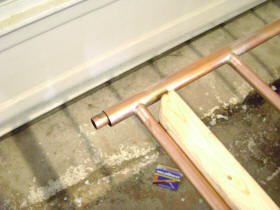
Half inch riser tube goes into flared
hole in 3/4 inch manfold. |
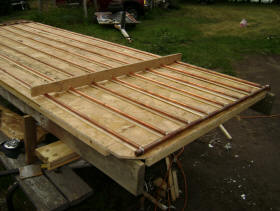
Notched board used to get even
spacing of riser pipes. |
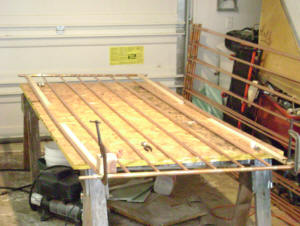
Pipes assembled and ready
for soldering. |
|
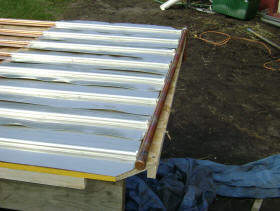
Shows the slope built into the bottom
manifold so that the collector drains
back to tank when pump is off. |
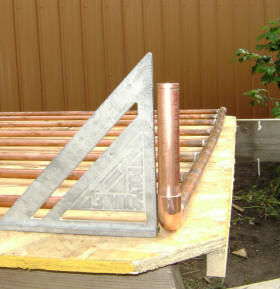
Shows the slope built into the bottom manifold,
and slope built into supply pipe. |
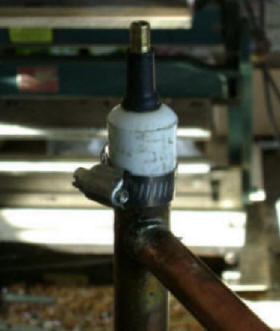
The completed copper tube grid was leak
tested with this arrangement. |
Making the Absorber Fins
The absorber plates are made from
aluminum siding from an old Trailer house (my first house). I cut them out for 6
inch by 24 inch finish sized panels, rolled them flat, and paint side up I
pressed a U-shape into them, then repressed them with the fixture (shown) to
get a better fit on the ½ in. copper pipe.
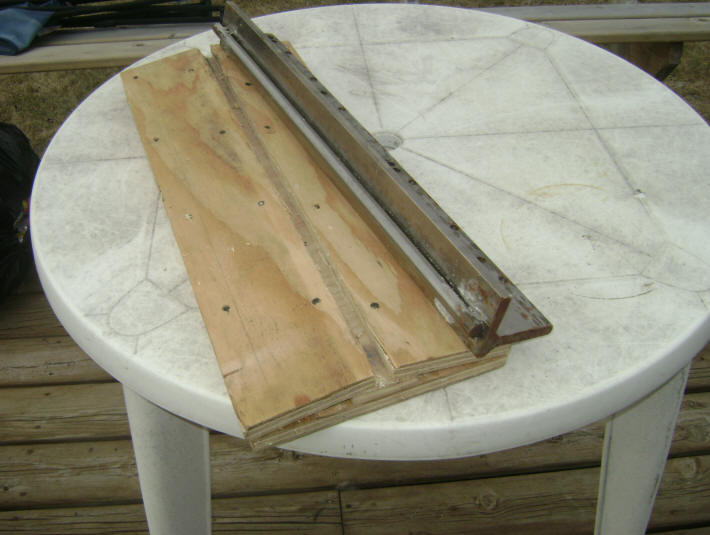
This tool was used in the press shown just below to press in the U shaped groove
in the aluminum.
This was followed
by the re-bending operation shown below, which gives the fins more
wrap around the copper tubes.
Click on pictures for full size
|
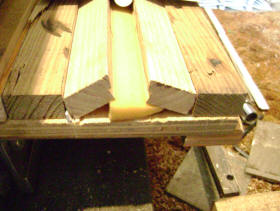
The "re-bending" tool used to wrap fins
further around the copper tubing. |
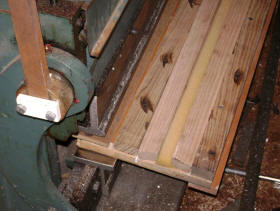
The "re-bending" tool in press. |
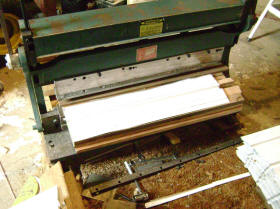
Fin in tool ready for re-bending. |

Finished absorber fins after "re-bending" to increase wrap on the copper tubes.
Installing Fins on
Copper Grid
When putting the pipes together I
made them ¾ in. out of square so when installed, they’d drain down. I put the
pipe assembly on ½ in. OSB with a 1/8 in. by 1½ in. spacer board/shim to hold
the absorber plates away from the OSB. Then a backing aluminum plate over that.
The copper pipe, silicone caulk, then the absorber plate are all stapled down with half
inch stainless steel staples. If I were to do this again I would used
these PVC clamps and Construction Screws.
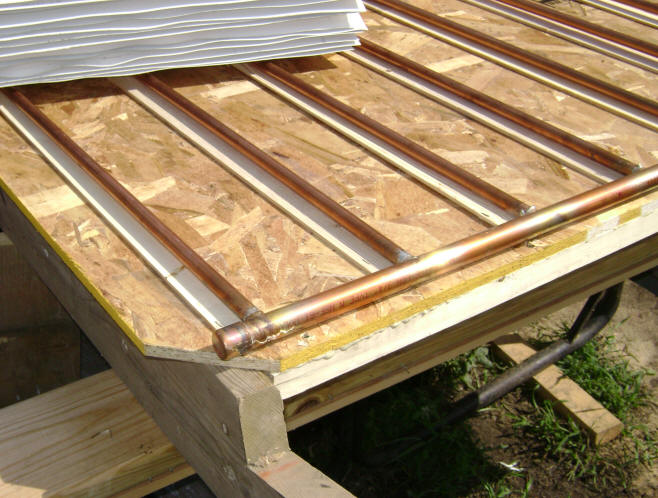
Copper grid
installed on OSB backing with 1/8 inch spacers to separate ready for
fins to be installed.
Click on pictures
for full size
|
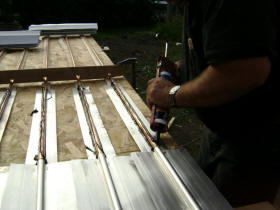
Narrow flat sheet goes under fins, then
light bead of silicone, then grooved aluminum
fins go over copper tubes and are stapled
tightly down. |
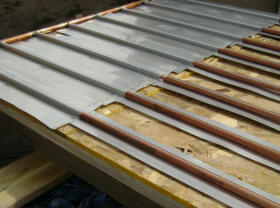
Absorber fins being installed. |
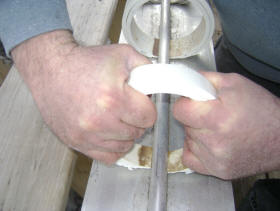
Clamp made from 4 inch PVC pipe
sections holds fin tightly to copper
tube before fastening. |
The spacers between the fin and the
OSB decrease the effective thermal mass of the fins by decoupling them thermally
from the OSB -- so the collector will respond faster to changes in sun
conditions.
The details on
how to make and use the clamps made from PVC pipe are here...
Painting
I painted the absorber plate
with high absorbency black paint.
|
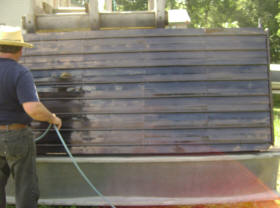
Painting the absorber with black paint. |
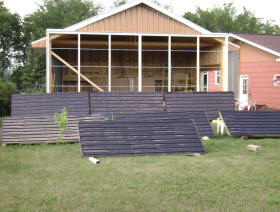
Absorber plates drying. |
Installing the Absorber Plates in
the Collector Frame
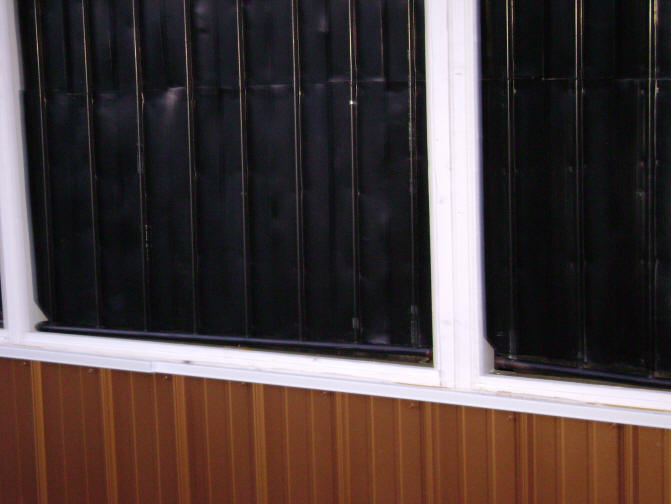
The absorber plates installed in the collector frame.
The Folding End Collectors

This picture shows the detail for the hinge that allows the two outside
collectors to either be folded out (for maximum winter
solar heat gain), or be folded in for less gain in the summer.
With the end collectors folded out, there are 8 active collectors,
and with the end collectors folded there are only 4 active collectors, so this
cuts the summer collection area to half what
the winter collection are is.
Kenneth is still working on a good
plumbing joint for the pivoting collectors -- he will let us know.
Click on pictures for full size.
|
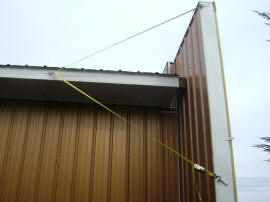
Collectors secured in winter position. |
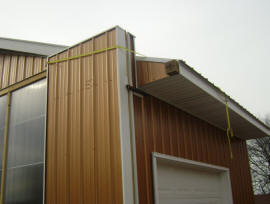
Collectors secured in summer position. |
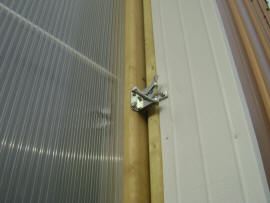
Latched in summer position. |
Back to the
main page...
On
to the tank and heat transfer trench...
Gary March 22, 2010















